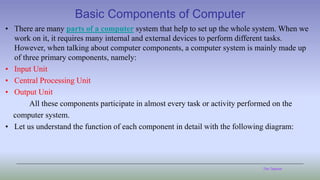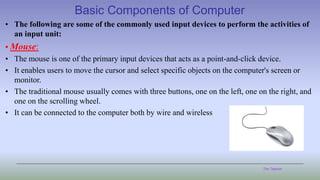Basic Components of Computer....pdf
- 1. The Teacher Basic Components of Computer • There are many parts of a computer system that help to set up the whole system. When we work on it, it requires many internal and external devices to perform different tasks. However, when talking about computer components, a computer system is mainly made up of three primary components, namely: • Input Unit • Central Processing Unit • Output Unit All these components participate in almost every task or activity performed on the computer system. • Let us understand the function of each component in detail with the following diagram:
- 2. The Teacher Basic Components of Computer 1. Input Unit: • The input unit contains the devices required to input data into a computer system. • The devices used to input data into the computer are called input devices. • Computers do not react or operate on their own, the input unit is one of the main components of a computer. • This unit establishes a link between the user and the computer so that the user can direct commands and data into the computer. • These devices take data from the users and send it to the computer in a systematic manner for further processing. Like other electronic machines, the computer system also accepts only raw data (binary data). Input devices convert the data inputted by the user into binary form for the computer to understand. Data can be entered or given in the form of text, alphabets, numbers, symbols, images, etc.
- 3. The Teacher Basic Components of Computer • The following are some of the commonly used input devices to perform the activities of an input unit: • Mouse: • The mouse is one of the primary input devices that acts as a point-and-click device. • It enables users to move the cursor and select specific objects on the computer's screen or monitor. • The traditional mouse usually comes with three buttons, one on the left, one on the right, and one on the scrolling wheel. • It can be connected to the computer both by wire and wireless
- 4. The Teacher Basic Components of Computer • Keyboard: • The keyboard is another essential input device that consists of several keys. • By pressing the keys, we can enter or input data like letters, numbers, signs, and other information on the computer.Like a mouse, it can also be wired and wireless. • Microphone: • Microphone, short for mic,is an optional input device used on computers. • When we need to insert audio into our presentation, do voice conferencing, recording, broadcasting, or giving voice commands to the computer, etc., we can connect a mic to the computer. • Microphones come in a variety of shapes and sizes. • It enables us to give voice input to the computer system. • The mics are designed to read sounds from the surroundings and convert this sound (analog waves) into electrical signals. • The signals are further converted into digital forms to be understood by the computer.
- 5. The Teacher Basic Components of Computer • Other examples of input devices include a webcam, scanner, touch screen, barcode reader, etc. 2. Central Processing Unit • The Central Processing Unit (CPU) is an essential electronic hardware component that controls and processes all functions in a computer system, including arithmetic and logical operations. • All simple to complex calculations, tasks, or comparisons are performed by the CPU. • It takes raw data from the primary memory, processes it or converts it into meaningful information desired by the users, and then sends the processed data back to the primary memory. • The CPU is called the brain of the computer because it controls the operation of all the parts of the computer. • Despite this, the computer's processor (CPU) also handles the operation of many other units within the computer system, such as the control unit, arithmetic logic unit, and memory unit.
- 6. The Teacher Basic Components of Computer • The Control Unit (CU) and the Arithmetic Logic Unit (ALU) are commonly called components of the CPU because they both together make up the CPU.
- 7. The Teacher Basic Components of Computer 3. Output Unit • The output unit contains the devices needed to receive and view information from a computer system. • The devices used to receive information or results from the computer are called output devices. • This unit is an essential component of a computer because without it we cannot obtain or see information or desired results. Like the input unit, the output unit also establishes a link between the user and the computer. • As we discussed above, the results obtained after processing are stored in the primary memory before sending to other units. • The output unit retrieves processed data from the computer's primary memory (main memory), which is converted into a human-understandable form before being displayed by the corresponding output device.
- 8. The Teacher Basic Components of Computer • The following are some of the commonly used output devices to perform the activities of an output unit: • Monitor: • A monitor, often called a visual display unit, is one of the primary output devices used on computers these days. • It is connected to a computer to digitally view the output (such as text, images, videos, etc.) on the screen. The output displayed on the computer's monitor is called soft copy output. • The monitor is typically made of glass, circuitry, adjustment buttons, power supply, etc., all enclosed within a casing.
- 9. The Teacher Basic Components of Computer • Printer: A printer is another essential output device used with computer systems these days. • Unlike a monitor, a printer helps us to make a hard copy of the desired output such as a document, picture, or other information on paper. • The printer takes electronic data from the computer and creates an exact copy of it in monochrome (in this context, black and white) or colors, depending on the type of printer.
- 10. The Teacher Basic Components of Computer • Speakers: • Speakers are used to receive audio/sound output from the computer system. They are optional and they can be connected to the computer only when we need to listen to something like music, movies, dialogues, etc. • Other examples of output devices include a projector, plotter, headphones, touchscreen, etc










